Barn Quilt Trail


The New Milford Barn Quilt Trail consists of 19 colorful quilt patterns hand-painted on large weather-resistant blocks and hung on antique and vintage barns and historical buildings around our town. It honors our rich agricultural history, the exciting resurgence of family farms in New Milford today and the American tradition of quilt-making. It is the first barn quilt trail established in Connecticut.
Already, over 40 U.S. states, including New Hampshire and New York, boast quilt trails in a rapidly expanding movement that began in Ohio in 2001. Get in your car or jump on your bike and use any mobile device to access this site as you visit these barn quilt block sites.
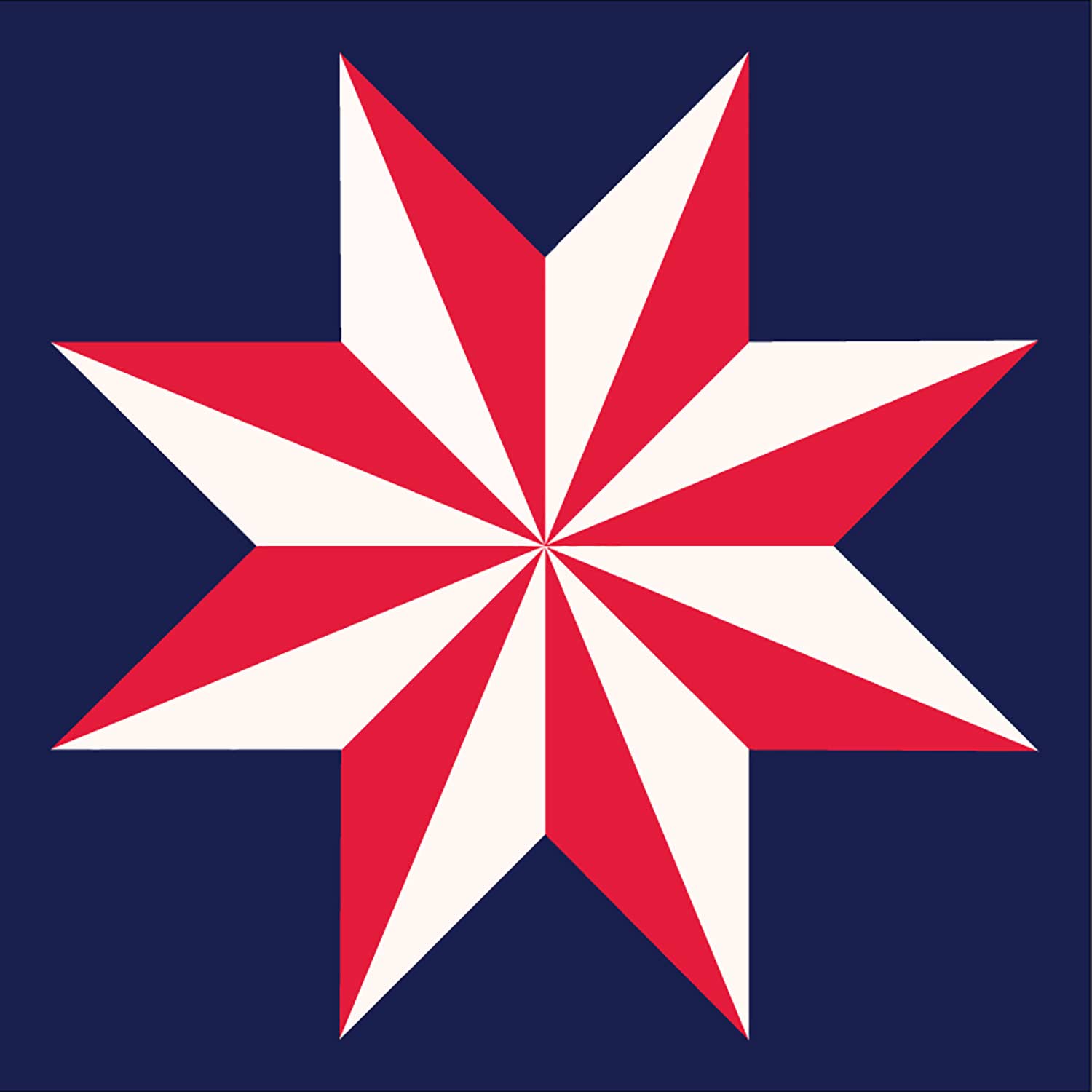
TRAIL MAP BARN QUILT LOCATIONS
1. Larson’s Sweet Corn – Larson Barn, 386 Danbury Road
2. Century of Growth – Sunny Valley Preserve, 8 Sunny Valley Lane
3. Blue Oars – GMS Rowing Center, 172 Grove Street
4. Tobacco Fields – Couillard Barn, 13 Dorwin Hill Road
5. Grandfather Hipp’s Cow – Centerbrook Farm, 150 Chestnutland Road
6. Red, White & Blue – 155 Chestnutland Road
7. Cows and Baskets – Harris Hill Farm, 122 Ridge Road
8. Five Leaves – Bright Green Farm, 173 Ridge Road
9. Mayor’s Garden – Old Tobacco Barn, behind Town Hall, 10 Main Street
10. Twin Horses – Geron Nursing Carriage Barn, 42 Main Street
11. Ferris Family Quilt – New Milford Historical Society, 6 Aspetuck Avenue
12. Maple Leaf – Sullivan Farm, 140 Park Lane Road
13. North Star – Lillis Farm, 241 Litchfield Road
14. Maple Leaves – Smyrski Farm, 227 Merryall Road
15. Our Mission! – Hunt Hill Farm, The Silo, 44 Upland Road
16. Forage Grass – Hunt Hill Farm Preserve, 60 Upland Road
17. Celtic Harvest – Finnegan’s Farm West Barn, 55 Upland Road
18. Tree of Life – Hacienda Polska, 93 Upland Road
19. Holstein Cow – Wieting Farm, 19 Wheaton Road
Please use caution as you drive, bike or walk along the country roads of the barn quilt trail. Remember that the quilt blocks are displayed on what is often private property and can be viewed only from public roadsides. Responsibility for any accidents while observing the quilt blocks rests entirely with the viewer.
Interested in having a barn quilt block on your New Milford property considered for inclusion on the New Milford Barn Quilt Trail? Click here for guidelines and application.
LARSON’S SWEET CORN
Larson Barn, 386 Danbury Road
This massive English-style bank barn built by Frank Larson in 1900 served one of the valley’s largest dairy operations. Larson, a native of Sweden, grew corn and tobacco along with maintaining a large dairy herd. The Larson family adapted to changing times in local agriculture for almost a century, surviving into the 1990s on the strength of their famous sweet corn, which they started selling in 1957 at their Route 7 farm stand. It is commemorated in the quilt block’s ear of corn design. Artifacts found during construction of the high school suggest that Native Americans occupied this area up to 8,000 years ago. The Larson barn has been listed on Connecticut’s State Register of Historic Places since 2006.
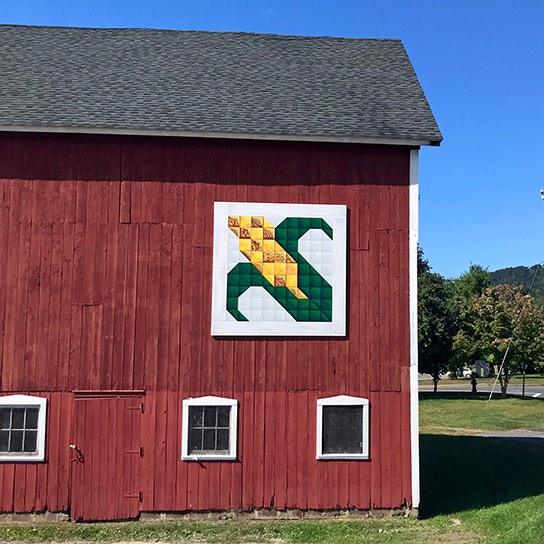
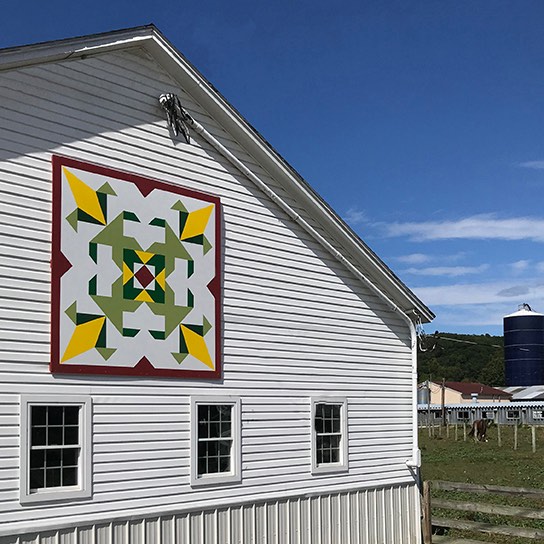
CENTURY OF GROWTH
Sunny Valley Preserve, 8 Sunny Valley Lane
The quilt block represents the long history of agriculture here. The triangular shapes at the corners evoke Indian arrowheads and ears of corn. This structure was built in 1938 as the main dairy barn by George Pratt, a member of one of the early founding families of Standard Oil. A Harvard graduate and rebel, he settled in Bridgewater and worked to save local agriculture. Formerly an extensive dairy and tobacco farm, Sunny Valley is one of five farms Pratt donated to The Nature Conservancy, which now leases them to independent farmers. Among them is Fort Hill Farm, once home to a Native American settlement and today a major producer of organic vegetables for local farmers markets.
BLUE OARS
GMS Rowing Center, 172 Grove Street
Farmer James Feeney, a native of Ireland, built this onetime tobacco barn in 1914 after a previous structure blew down. After tobacco farming declined, a succession of owners used it for a variety of purposes, including stabling horses and storage. Hidden by overgrowth, the building was known only to a few until 2004, when it was renovated as a boathouse for GMS Rowing. That earned it a Preservation Award plaque from the New Milford Trust for Historic Preservation. The quilt block incorporates the colors of GMS Rowing and the barn’s use as part of a revitalized riverfront.
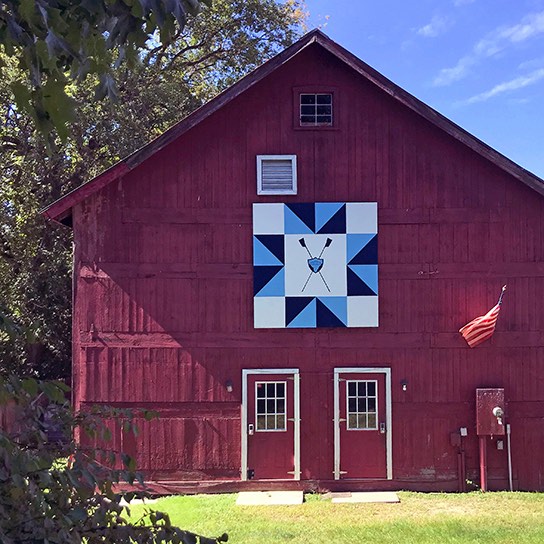
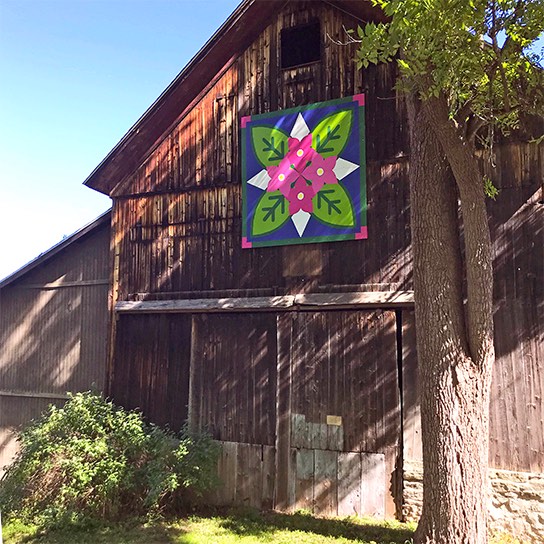
TOBACCO FIELDS
Couillard Barn, 13 Dorwin Hill Road
The tobacco leaves and flowers that inspired the quilt block’s design tell the story of this remarkably intact tobacco barn. J. Stuart Halpine, later the biggest grower and dealer of sun-grown tobacco in the Housatonic Valley, built it and another large barn, since demolished, on prime tobacco land along Town Farm Brook that he bought in 1883. Large doors on both ends allowed unloading of the harvested leaves, lath was hung on poles inside the structure, and hinged vents and louvers could be opened for air circulation to cure the leaves.
GRANDFATHER HIPP’S COW
Centerbrook Farm, 150 Chestnutland Road
Jesse and Brittany Miller selected a cow pattern to honor the late James Hipp, who originally ran the dairy operation and taught Jesse everything he knows. This English-style bank barn has been in the Hipp/Miller family since 1896 and was probably around for a century before that. As part of a working farm, the barn is used for storing hay and milking cows in the basement. When the family acquired the property, it had been adapted for use as a tobacco barn. Today the Millers carry on the land’s agricultural tradition as Centerbrook Farm on 50 acres. It offers a CSA (Community Supported Agriculture) and a front porch where vegetables, eggs and meat are regularly available for purchase in season.
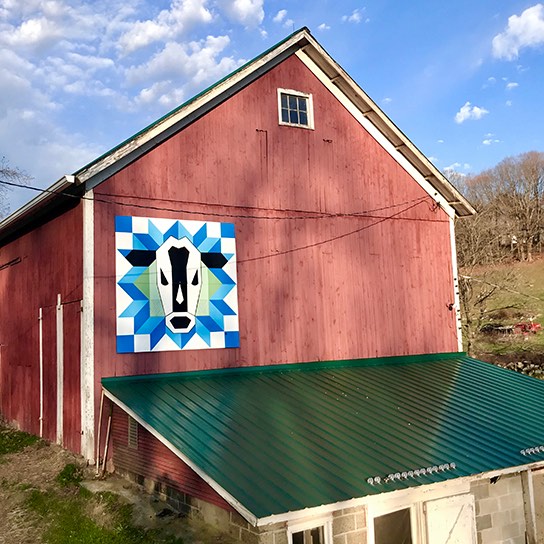

RED, WHITE & BLUE
155 Chestnutland Road
The colorful quilt block painted by the owner is the “United States of America” pattern in red, white and blue. This building was once part of a larger collection of barns on the property, which was farmed by the Solomon Northrop and John and Mary Richmond families during the 19th century. Its hand-hewn framing timbers indicate that it dates to the late 18th or early 19th century, judging by the nearby farmhouse. It is mentioned on a deed in 1847 and is represented on an 1853 map. It was later converted to a tobacco barn, with hinged siding that could be lifted to cure the leaves.
COWS AND BASKETS
Harris Hill Farm, 122 Ridge Road
The Harris family chose this barn quilt block design to honor their farm’s history. It is hung on an older barn that was raised in height in the 1980s to accommodate modern farm machinery for a thriving dairy operation. The 150-acre farm was purchased in 1957 by George Harris, an international expert on the Brown Swiss cows he raised. His grandfather was one of first U.S. importers of this hardy breed. George’s wife, Vivian, was recognized statewide for her tireless advocacy of farmers during a challenging time for farming in Connecticut.
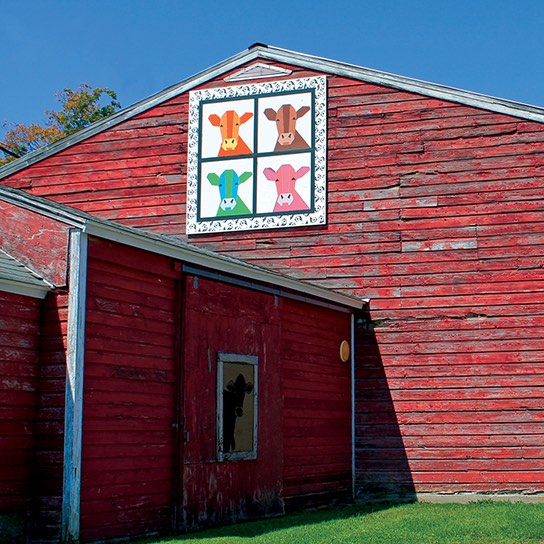
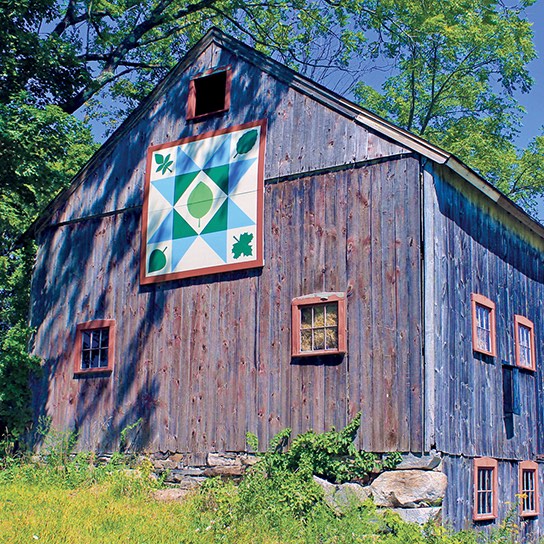
FIVE LEAVES
Bright Green Farm, 173 Ridge Road
The five different leaves depicted on this barn quilt block are rich in meaning for the Duffy-Reisberg family, who purchased this antique farm in 2016. The chestnut leaf in the upper left corner represents historic Chestnut Land, the name of the 19th-century district of the original subsistence farm, which belonged to the Canfield Family. The birch leaf in the lower left corner represents the Duffy-Reisbergs’ heritage in Eastern Europe, where birch trees abound. The maple leaf in the lower right corner is a nod to the mature maple trees that line the driveway. The apple leaf in the upper right corner commemorates the apple trees on the farm that legend holds were planted sometime after the Civil War. According to Karen Duffy, the bright green elm leaf in the center of the design symbolizes Mother Earth, signifying the “bright green” school of environmentalism that focuses on sustainability, a core value at the farm.
MAYOR’S GARDEN
Old Tobacco Barn, behind Town Hall, 10 Main Street
Former Mayor Patricia Murphy, a longtime quilter and the original advocate of the New Milford Barn Quilt Trail, chose the quilt block design from Barbara Brackman’s Encyclopedia of Pieced Quilt Patterns. Architectural details on the small barn suggest that this mid-to-late 19th-century structure was used in part for warehousing tobacco, a major industry in Connecticut at that time. These include reinforced posts under the summer beam, a boarded-up trapdoor that may have been used as an opening for a hoist, and shouldered supports that would have distributed the weight of the 300- to 500-pound cases of packed tobacco stores on the second floor.
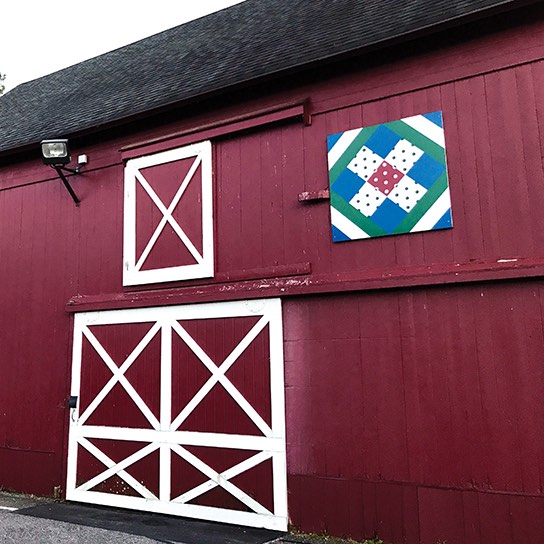
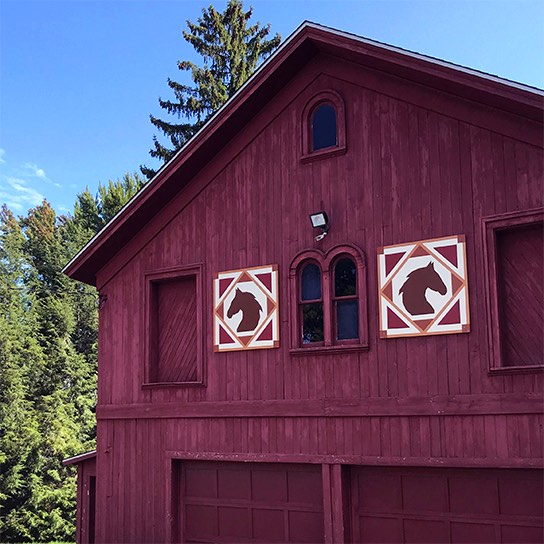
TWIN HORSES
Geron Nursing Carriage Barn, 42 Main Street
The Victorian house on the green has been repurposed as a nursing and home aide service. It was built in 1857 by Dr. James Hine, also a founder and president of the New Milford Savings Bank. It was sold in 1870 to tobacco dealer, farmer and businessman Henry Orange Warner, who updated the house, adding the mansard roof and front porch. He probably built this carriage barn as it’s the same architectural style as the house. Carriage houses represent a transition from the traditional barn to the modern garage, having been used for both vehicles and horses on the first floor and hay storage on the second. The horse head quilt block designs recall this legacy.
FERRIS FAMILY QUILT
New Milford Historical Society, 6 Aspetuck Avenue
The tulip pattern of the quilt block was adapted from a Ferris family quilt made in 1853 that is part of the historical society’s collection. It represents New Milford’s early Colonial farming settlers. The block hangs on Senator Elijah Boardman’s former store building, which served local farmers as well as townsfolk. Built in 1796, it housed a store into the 1840s. Boardman’s daybooks, still in existence, document his role as the middleman in the agriculture of the day, accepting produce from local farms and shipping it to the coast, then bringing back imported textiles, tools and other necessities and luxuries for local families.
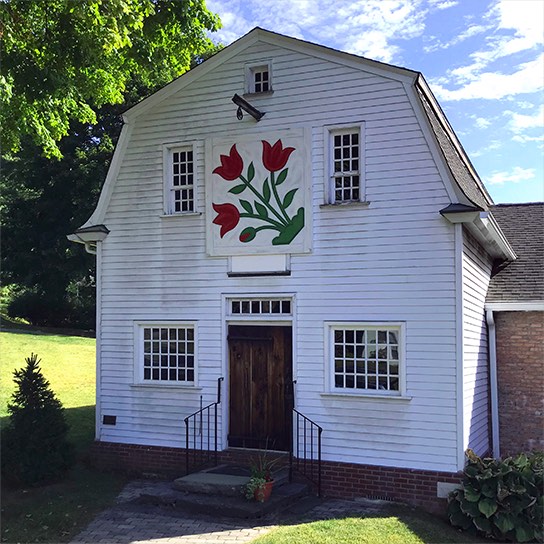
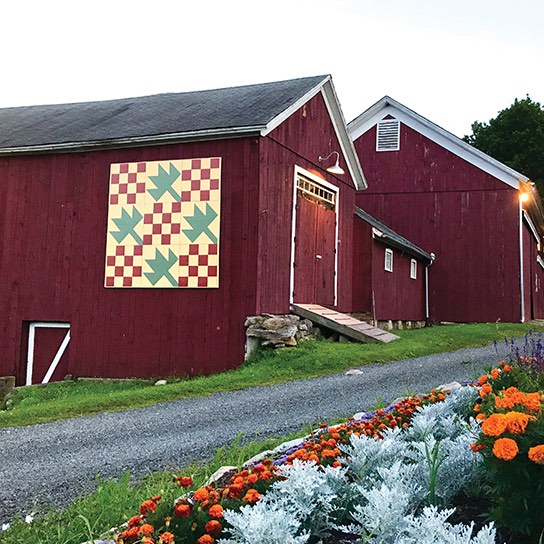
MAPLE LEAF
Sullivan Farm, 140 Park Lane Road
This barn quilt block design, adapted from a popular 1880 design, highlights maple syrup production, one of several agricultural products produced there today. High school and college students tap maple trees throughout southern Litchfield County in late winter, producing maple syrup at the on-site sugarhouse. The landmark barn, on which the barn quilt block is hung, was built in 1869 by William Sullivan. He was the great-grandfather of Jake Sullivan, who sold the dairy farm to the town, stating in the deed that the farm always be used to benefit the community. Today, young interns at the repurposed farm grow a wide range of produce that is sold at the on-site farm stand, through area farmers markets and in local specialty grocery stores.
NORTH STAR
Lillis Farm, 241 Litchfield Road (Route 202)
The quilt block, with its eye-catching North Star quilt square design, hangs on a white barn that originally housed workhorses. The year 1929 appears on two of the doors, indicating when the barns were rebuilt with older foundations from the site. A nearly identical dairy barn stands a few hundred feet to the south. The farm they served belonged to the Baldwin family in the early 19th century, when the barn foundations probably were built. Albert N. Baldwin, who lived here his whole life, was an early 19th-century state legislator known for his work on prison reform. The farm is no longer actively worked.
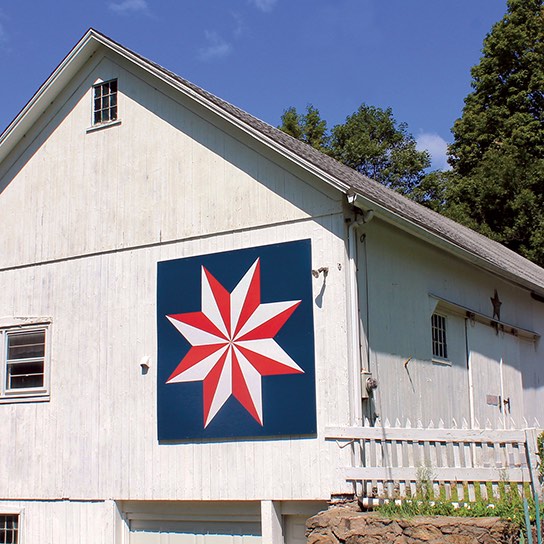
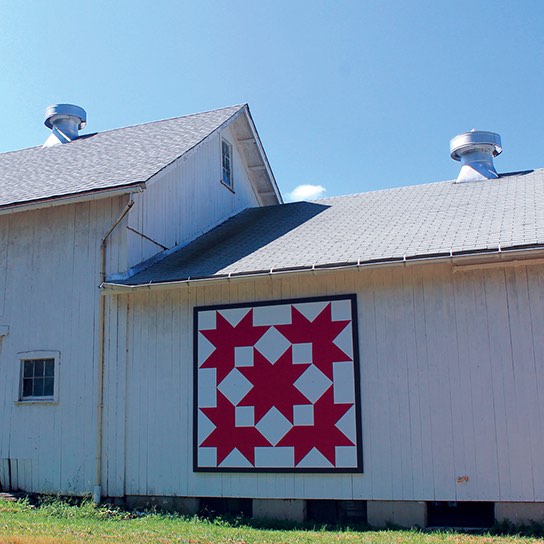
MAPLE LEAVES
Smyrski Farm, 227 Merryall Road
The quilt depicts a solid eight-pointed star in its center with stylized maple leaves in each corner. The design symbolizes sugar maple trees tapped for syrup there. A dairy operation until the mid-1980s, the farm is named for Adam Smyrski, who emigrated from Poland in the early 1900s. It was donated to the Northwest Connecticut Land Trust, Connecticut’s largest land trust, in 2008 by the last remaining Smyrski children. The 220-acre property produces hay, livestock and maple syrup and hosts environmental education programs.
OUR MISSION!
Hunt Hill Farm, The Silo, 44 Upland Road
A country cultural and culinary nonprofit is housed in a repurposed 19th-century bank barn. It was founded in the early 21st century by famed bandleader Skitch Henderson and his wife, Ruth, with a mission of “cultivating love of the land, food and the arts.” The red heart on the upper left corner of the barn quilt block symbolizes love; the flower in the upper right corner, the land; the basket of fruits and vegetables in the lower left corner, food; and the artist’s palette and musical notes in the lower right corner, the arts. The 137-acre farm was established by the Hendersons in the 1970s by combining two farms formerly owned by the Hine and Buckingham families.
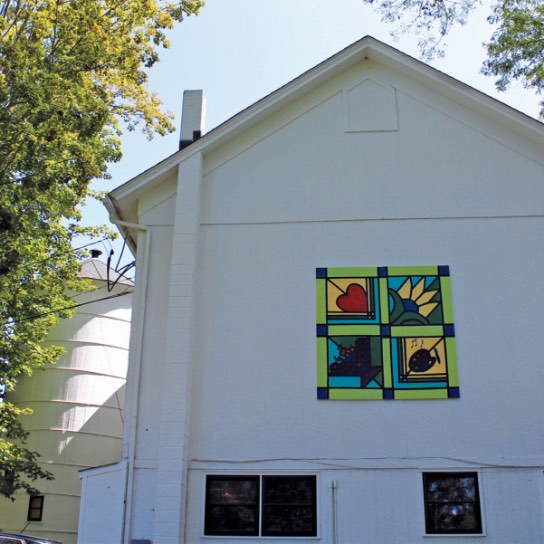
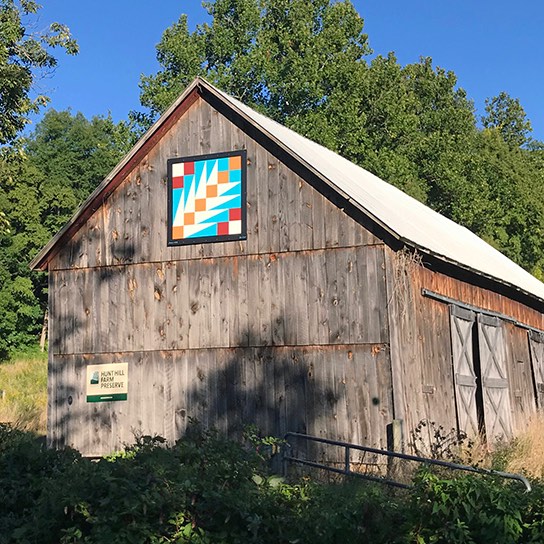
FORAGE GRASS
Hunt Hill Farm Preserve, 60 Upland Road
The Northwest Connecticut Land Trust chose a barn quilt pattern that symbolizes the forage grass grown in the surrounding pastures and hayfields of the farm, which thrived as a dairy operation from 1850 to 1964. Thanks to the New Milford community’s support for conservation and agriculture, Hunt Hill remains a working farm that provides pasture for livestock, hay and Christmas trees. The extended English-style field barn was built circa 1900 and likely housed hay for cows during the winter. Owing to former owners Ruth and Skitch Henderson, the land trust permanently protects 77 acres of Hunt Hill Farm. Of that, it owns 43 acres and has a perpetual conservation easement on 34 acres owned by the town of New Milford.
CELTIC HARVEST
Finnegan’s Farm West Barn, 55 Upland Road
Though at first glance the quilt block is reminiscent of a Pennsylvania Dutch hex sign, its symbols reflect the farm owners’ Irish roots. The Finnegans began homesteading here in 2012. Their design features a Celtic trinity knot in the center, representing the eternal bond among people, animals and plants. It was inspired by “the magnificent colors of fall, symbols of growth, harvest and Irish culture.” The couple believe strongly in “restoring the earth by respecting nature as the Native Americans have taught us.” They hope the quilt block “brings feelings of warm welcomes, gatherings of friends and family and fulfillment.” The couple raise cattle and other livestock on 20 acres and grow vegetables naturally through permaculture for sale at their farm stand. They also offer agritourism.
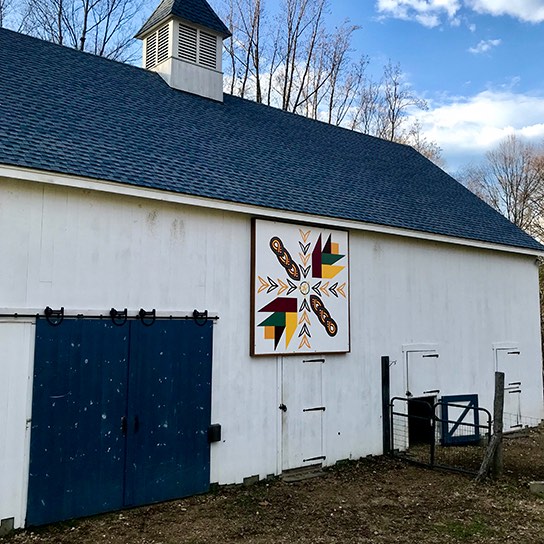
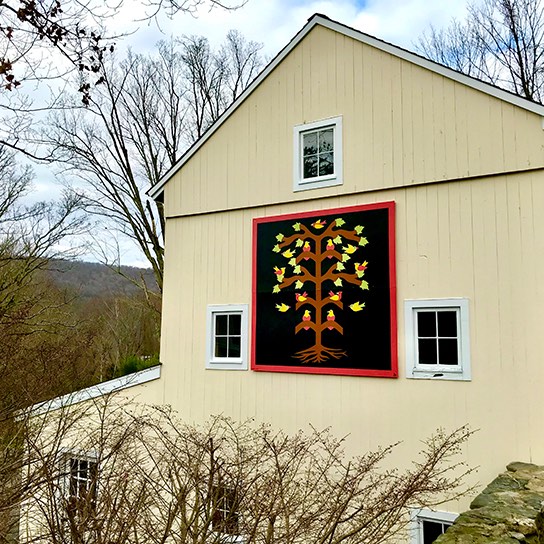
TREE OF LIFE
Hacienda Polska, 93 Upland Road
The Tree of Life design on this quilt block was chosen by owners Francisco Drohojowski and Saun Ellis for two reasons: it represents Francisco’s connection to Mexico, where he grew up, and incorporating maple leaves, typical of New England, it honors the enormous old, signature maple tree that continues to thrive on the property. The barn on which the quilt block is hung appears on an 1853 map of New Milford and probably dates to the early 19th century. Built with hand-hewn posts and beams, the former barn is part of the extensive farm holdings of the Buckingham and Hunt families. The barn itself was part of a larger complex of barns, one of which still stands to the rear of the main house. This property was continuously farmed for 200 years from the 1750s to the 1950s.
HOLSTEIN COW
Wieting Farm, 19 Wheaton Road
The design was inspired by “Patriotic Cow,” by quilter Mary Henzel of Oberlin, Kansas, although the Wieting cow design is black and white, rather than the original brown. This is because the Wietings have maintained a dairy herd of black and white Holsteins at the farm for more than 40 years. The English-style barn was rebuilt in the 1920s after a fire, when it was part of the Carlson Farm. The current barn was built on the same footprint and incorporates some surviving timbers of a barn possibly from the 19th century.
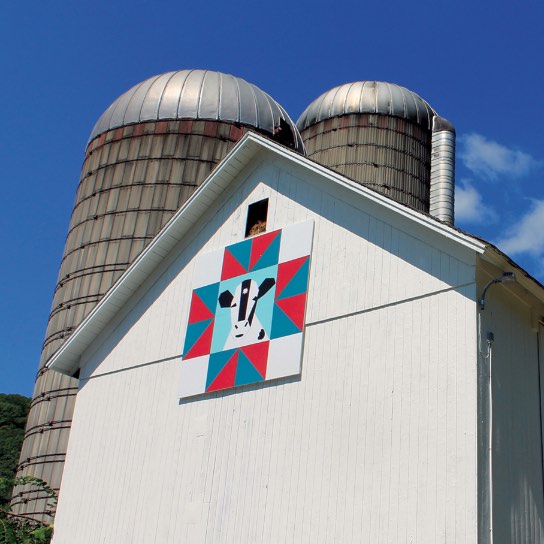
OTHER NEARBY TRAILS IN NEW MILFORD
Northwest Connecticut Land Conservancy
https://ctland.org/our_trails/
Four very different trails on the preserve are open to the public.
The New Milford River Trail
www.nmbikewalk.org
Two stretches, totaling over 5 miles of this envisioned 13-mile trail, are complete and offer beautiful views of the Housatonic River.
Text researched and written by William Devlin, Board of Directors, The New Milford Trust for Historic Preservation
Photography by Linda Pouder of Merryall Studio.